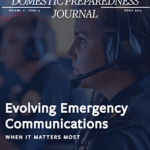- Agriculture & Food Defense, Articles, CBRNE, Critical Infrastructure, Cybersecurity, Emergency Management, Hazmat, Hospitals, Law Enforcement, Public Health, Science & Technology, Terrorism, Transportation
- by: Benjamin Lieb & Jason Bashura
Following the terrorist attacks on the United States, the federal government began to ramp up its arsenal of subject matter experts in the public health arena as it related to the threat of bioterrorism. Among these disciplines, experts in the subjects of food defense and food security were being identified and sought after for a variety of new opportunities to protect the food supply. Intentional acts of contamination in the food supply have occurred for thousands of years. Recently there were reports of Ukrainian citizens feeding Russian soldiers poisoned cake and alcohol that resulted in 2 deaths and 28 other soldiers hospitalized. The Food Defense Consortium and the ASIS Food Defense and Agriculture Security Community (FDASC) recently made an effort to update a foundational food defense research paper and offer recommendations for future research to continue improving knowledge in this area.
“For the life of me, I cannot understand why the terrorists have not attacked our food supply because it is so easy to do.”
– Former Secretary of Health and Human Services, Tommy Thompson (2004)
Background & Data Collection
As a background, it is important to understand the definitions of a few key terms:
- Food defense – “The efforts to prevent intentional contamination of food products by biological, chemical, physical, or radiological agents that are not reasonably likely to occur in the food supply” (as defined by the Food and Drug Administration).
- Food security – “The reliable availability of a sufficient quantity and quality of nutritious food for a population” (as defined by the World Health Organization in 2002).
- Food protection – The nexus between the food safety practices that are leveraged every day and food defense strategies that are intended to reduce the likelihood of an act of intentional contamination from occurring in the food supply. Elements of food fraud mitigation, food quality, environmental health and safety, and physical security also comprise the concept of food protection.
An internship opportunity in 2022 by the Food Defense Consortium and the FDASC was seeking to have the foundational research paper by G. R. Dalziel, “Food Defence Incidents, 1950-2008: A Chronology and Analysis of Incidents Involving the Malicious Contamination of the Food Supply Chain” updated to include events since 2008. Dalziel is one of the first, if not the first, to write a compendium about incidents of intentional and malicious contamination. This is done by examining the cases comprehensively and systematically – throughout the whole food supply chain. Dalziel’s research paper discussed how the World Health Organization defined the difference between food security and food defense while also discussing how the United States and the Department of Homeland Security (DHS) are involved in the food and agriculture sector.
Dalziel concluded that 98% of the cases occurred later in the food supply chain – nearest to the consumer. Intentional contamination also occurred most often in the food service/retail environment, home, or workplace, while cases at the food service point had the greatest impact on the public’s health. While Dalziel also concluded that the total number of casualties was low, the updated appendix also followed this trend – with a few outliers. Of the total number of cases per country, Dalziel had collected 60% of his cases from the United States, the United Kingdom, and Australia. He stated that this is because of the wider proliferation of the western media, with the first case in China not being reported until 1992. The number of cases rose in the mid-1980s with increased extortion cases in retail/food service. However, between 2004 and 2008, there was a decrease in annual reported cases.
The research completed in 2022 included updating events that occurred after 2008 – plus a few that had occurred in 2008 but were not captured by Dalziel. The cases in the appendix are sorted into five categories of agents: chemical, biological, radiological, physical contaminant, and unknown. Many of the cases fell under the classification of chemical. Data collection to update the appendix involved open sources (e.g., news articles and peer-reviewed articles) and collaborators within the Food Defense Consortium and the ASIS FDASC, who submitted incidents for review and inclusion in this updated research. After reading through the different cases, it was determined whether they were intentional acts of contamination. The cases were then categorized by year, country, agent, agent type, number of injuries, number of deaths, and a description of the incident. An analysis was produced on some cases to better understand their contents and the method used (see Figure 1).

Mitigation
There are ways to mitigate the risk of food being intentionally contaminated. One way is for food manufacturers to update procedures regularly to ensure that the product cannot be easily accessed, thereby decreasing the feasibility of contamination. The updated procedures can prevent current and former employees from tainting products in the food supply chain. The U.S. Food and Drug Administration (FDA) has developed a resource to aid private sector owners and operators in identifying mitigation strategies to help decrease the intentional adulteration (i.e., contamination) of food in production environments.
The Mitigation Strategies Database “is intended as a starting point for facilities to consider when identifying potential mitigation strategies.” Additionally, completing basic food defense awareness training is an important step in raising awareness of food defense concepts, which can directly contribute to reducing the risk of intentional adulteration. For example, free food defense awareness training is available on the Food Safety Preventive Controls Alliance website – for food workers at the retail level (nearest the consumer interface) to manufacturing (food production) and transportation/distribution personnel.
Evaluating events in the past can help predict – and possibly prevent – similar incidents from occurring in the future.
In a strategic and academic sense, another way to help mitigate the number of intentional cases is by updating research (like this endeavor described herein) to demonstrate the methods by which individuals have contaminated food and drink in the past and doubling down and refocusing efforts in these areas moving forward. Operationally, by performing tabletop and functional exercises with cross-functional disciplines represented (regulators, law enforcement, emergency management, food industry), a variety of perspectives can be gleaned, and strengths – as well as gaps – can be identified in these emergency response plans.
The U.S. Department of Agriculture’s Food Safety and Inspection Services, FDA, and DHS have all created tabletop exercise toolkits to aid in executing an exercise. However, these resources need to be more readily accessed if they are going to have the intended impacts on the community they are targeted at protecting.
In 2021, one of the teams participating in the DHS’s Analytic Exchange Program group focused its research and summary report on critical infrastructure sectors that might be overlooked during a wide-scale natural disaster or man-made event. The final toolkit related to that research is slated to be released at the end of 2022.
Impact of This Analysis
The importance of updating the appendix to Dalziel’s work is to better understand how those seeking to harm others have continued contaminating food supply chain products. Mitigating future acts requires an understanding of the products that have been contaminated, the methods used to contaminate the products, and the reasons behind these actions. Some of the reasons why an individual would contaminate food include:
- An ex-employee seeking revenge;
- A current employee unhappy with their position within the company;
- Retaliation for punishment, delayed promotion, or unfair treatment in the workplace;
- Someone seeking recognition for being diligent in the production environment; or
- Someone simply looking to harm others.
The updated appendix, which can be accessed at the Food Safety Tech’s Food Defense Resource Portal (Figure 1), allows for more research on the methods and types of individuals committing these acts. In the future, additional analysis should be performed on the new Appendix I to “categorize” the rationale behind why the contamination occurred. These categories are:
- Type I – Offender has no legitimate relationship with the business or its employees;
- Type II – Offender has a legitimate relationship with the business (as a customer, client, patient, student, or inmate);
- Type III – Offender could be a current or past employee;
- Type IV – Offender may or may not have a relationship with the business but has a personal or perceived relationship with an employee; and
- Type V – Offender is an extremist or value-driven group who feels justified by their beliefs.
Call to Action
The outcomes of this research are important for food protection or safety regulatory programs or those officials from state, county, and local emergency management because it demonstrates the different tactics that can be used to contaminate food within the food supply chain. Although gaining insights into solutions to prevent contamination events in the future may be reactive, understanding the methods of contamination will allow for preventative measures and awareness programs to be put in place. A review of the historical events listed in Dalziel’s report and the updated content from the new Appendix I document show that history is likely to repeat itself if actions are not taken now to prevent similar incidents.
“…But if you close your eyes, does it almost feel like nothing changed at all? And if you close your eyes, does it almost feel like you’ve been here before?” – Bastille, “Pompeii” October 11, 2013
Finally, further research is needed to evaluate the variation in punishment regarding the penalties related to intentionally adulterating, tampering with, or knowingly introducing contaminated (or potentially contaminated) food, not only within the U.S. but globally. For example, in January 2009, two individuals found guilty of their involvement in China’s 2008 melamine scandal – which resulted in 6 deaths, 54,000 hospitalizations, and more than 300,000 affected children – were sentenced to death. Meanwhile, those found guilty for their involvement in a U.S. outbreak associated with contaminated peanut butter were each sentenced to between 60 and 336 months in prison “for their roles in a conspiracy to defraud their customers,” which led to 9 deaths and more than 20,000 illnesses.
Summary
The methods of contamination identified in Appendix I will allow for future discussion among cross-functional, multi-disciplinary practitioners on how to prevent and respond to future incidents. Participating in tabletop and functional exercises can help preparedness professionals thwart terrorists and other bad actors from contaminating food (and prove Secretary Thompson wrong). After response plans have been created, they can be tested in a controlled environment utilizing various existing resources to test their effectiveness. Yesterday’s plans need to be revised to protect against all of tomorrow’s threats. Continuous improvement is necessary to stay ahead of the curve and make a change for the better, for tomorrow. Future iterations of food protection plans need to address a wide variety of threats – those originating from cyber, physical, people sources, or cascading failures of interdependent infrastructures. Food protection plans aim to reduce enterprise risk for food manufacturers and retailers globally and protect the public’s health and well-being.

Benjamin Lieb
Benjamin Lieb is originally from Cincinnati, Ohio. He attended Coastal Carolina University, where he earned a B.A. in Intelligence and National Security Studies with minors in Anthropology and Criminology. While at Coastal Carolina, he was named to the President’s and Dean’s lists. Since graduating in May 2022, he has started his career in the Intelligence Community as an officer at the U.S. Department of Homeland Security Transportation and Security Administration. He would like to thank Dr. Smith, the Members of the Food Defense Consortium, the ASIS Food Defense, and Ag Security Community for supporting his throughout this research.
- Benjamin Liebhttps://domesticpreparedness.com/author/benjamin-lieb

Jason Bashura
Jason Bashura has been working within the food defense arena since 2002, when he began working with the Connecticut Department of Public Health’s Food Protection Program as a food biosecurity (now known as food defense) environmental health sanitarian. After transitioning to the U.S. federal government, he was a food defense policy analyst with the U.S. FDA’s Food Defense team where he oversaw the development and utilization of the Food Related Emergency Exercise Bundle (FREE-B) among other critical food defense initiatives. Currently working in industry, he has been leading the informal Food Defense Consortium – in order to bring together those parties with a vested interest in global food defense issues. He is proud of the countless relationships he’s dedicated global government, industry, and academic leaders, in an attempt to connect the innumerable dots within the food defense arena. He has a master’s degree in Public Health from the University of Connecticut (UCONN) and an undergraduate degree in Public Health from Southern Connecticut State University. He currently resides in Maryland with his family and serves on the Board of Health in the county where he resides.
- Jason Bashurahttps://domesticpreparedness.com/author/jason-bashura
- Jason Bashurahttps://domesticpreparedness.com/author/jason-bashura






